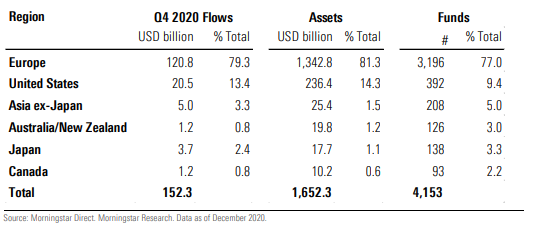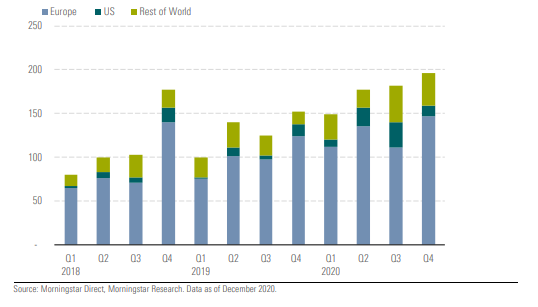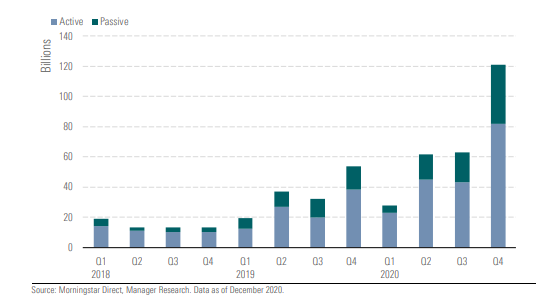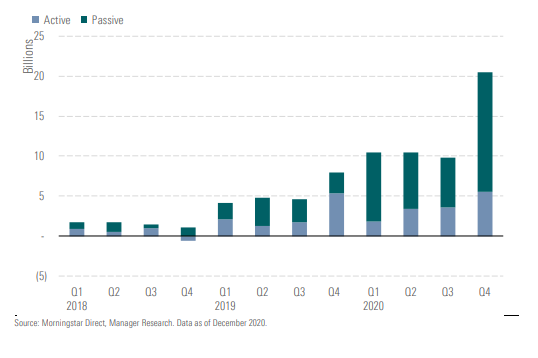Assets in sustainable funds worldwide hit a record high of $1.652trn as of the end of December, up 29% from three months earlier, according to Morningstar Direct.
They received a large boost in the final quarter of 2020 where global inflows climbed 88% to $152.3bn, with Europe accounting for almost 80% of these inflows, according to the latest Morningstar Global Sustainable Fund Flows report.
The US took in 13.4%, up slightly from 12% in the third quarter of the year, while inflows amounted to $11.1bn for Canada, Australia and New Zealand, Japan, and Asia combined.
Global Sustainable Funds Q4 2020

Author of the report, Hortense Bioy, director of sustainability research for EMEA and APAC at Morningstar and editorial panellist for ESG Clarity, said the “fourth quarter was the most prolific quarter of all times in terms of product development”.
See also: – Global sustainable fund assets leap to all-time high of above $1trn
New product launches in the fourth quarter also hit an all-time high, with 196 new offerings, including 37 in countries outside of Europe and the US. Asset managers also continued to repurpose and rebrand conventional products into sustainable funds, with at least 250 such funds in Europe.
Global Sustainable Fund Launches Per Quarter

Also, consistent with record numbers of fund launches, repurposed funds hit new highs last year: Morningstar identified 253 such funds, 87% of which reflected the change by rebranding.
Europe
Looking at the European region specifically, Bioy said sustainable fund flows reached “stratospheric heights” in Q4 with $120m in net new money, after a decline in inflows earlier in the year as the market absorbed the Covid-19 impact.
“Flows were up 84% on the previous quarter, giving a strong finish to the year,” the report said. “The longer-term flow picture looks even more striking, with inflows into European sustainable funds almost 5 times higher in 2020 than they were three years ago and almost double last year’s, at $273bn.”
European Sustainable Fund Flows ($bn)

Equities remained the asset class of choice for ESG investors with $82bn flowing into funds invested in stock markets, more than double the previous quarter, while fixed income also saw a significant share of the flows.
The report also highlighted the resilience of sustainable assets as the pandemic unfolded, and also growth in passive market share in Europe.
“Assets have been consistently high quarter over quarter, including in the first quarter 2020,” it said. “To the surprise of many, sustainable funds proved remarkably resilient during the Covid-19 market sell-off. Assets dropped by only 10.6% in first-quarter 2020, while the overall European fund market took a greater hit of 16.2%. Assets in sustainable funds recovered in the second quarter to hit the USD 1 trillion-mark for the first time this year. The fourth quarter experienced the highest growth of 2020, amounting to over 23.2%.
“Passive funds have seen their market share increase considerably over the years, now accounting for 22.5% of the European sustainable fund market, up from 18% three years ago.”
See also: – ESG fund outperformance began well before Covid downturn
Regulation
Bioy also said that while 2020 was a pivotal year in terms of ESG investing, increasing flows and sustainable activities to meet the European Union’s goal of a net-zero economy by 2050, this year will also be important with upcoming regulation focused on this area.
“Perhaps the biggest—yet uncertain—piece of the EU Sustainable Finance Action Plan keeping asset managers busy last year was the Sustainable Finance Disclosure Regulations (SFDR). Taking effect on 10 March 2021, the new rules require firms to provide information about the ESG risks in their portfolios and classify their products into one of three categories that will dictate additional disclosure requirements (Article 8 or 9 products).
“For investors, the new rules will constitute welcome protections from being green-washed. Regulators developed the disclosures to require clearer articulation of funds’ ESG objectives and for those objectives to be substantiated with metrics. Investors will get more data on how a fund is doing against its objective, together with guidance on how to compare that progress. They will also be told not only about the sustainability risks that pose a threat to their investments but also about any negative effects, or principal adverse impacts, those investments might have on sustainability—the so-called double materiality. This regulation is opening up a new era packed with possibilities for investors and will bring confidence to the sector.”
US
The US also recorded an all-time record of flows in Q4 – after averaging just more than $10bn per quarter in the first three quarters of 2020, sustainable funds saw $20.5bn of net new money in the final quarter.
“That brings the total US sustainable fund flows for 2020 to $51.bn, more than doubling the previous calendar-year record of $21.4bn set in 2019. Prior to that, the record for a calendar year was only $5.bn, set in 2018.”
US Sustainable Fund Flows ($bn)

It added equity funds attracted 90% of these flows for Q4 and the year overall, and while fixed income was not as popular, the asset class still surpassed the $2bn mark in Q3 for the first time and again in Q4.
Passive funds drew 70% of the flows in each with the report commenting “the dominance of passive flows is more recent among sustainable funds than it is in the broader US funds universe”.
Of the 71 new sustainable funds launched in the US, a calendar-year record, 12 were launched during the fourth quarter and 10 were ETFs. Invesco added two actively managed ETFs (Invesco US Large Cap Core ESG ETF and Invesco Real Assets ESG ETF), and several offerings focused on the carbon transition including GlobalX CleanTech ETF, JPMorgan Carbon Transition US Equity ETF, and SmartETFs Sustainable Energy II ETF.
Asia
Total ESG assets in the Asia ex-Japan region amounted to $25.4bn at the end of last year, fuelled by inflows of $7.9bn, up from only $810m in 2019, Morningstar said.
Allocation funds raised $4.6bn in net flows in 2020, followed by equity mandates with $2.3bn and fixed income with $1bn. However, equity remained the largest asset class represented, with $13.2bn in assets, recording a strong growth of 94% in 2020 over 2019.
The report said: “China, South Korea, and India had strong positive ESG flows for the fourth quarter of 2020, propelled by new launches. While China’s fourth-quarter data captured only 60% of ESG funds at the time of publication, investors interest in the electric-vehicle theme drove China’s fourth-quarter ESG flows to a record $3.8bn.”
Asia ex-Japan Sustainable Fund Flows ($m)

The final three months of last year were especially good for sustainable funds in the region, which attracted a record quarterly high $5bn of net inflows.
“The disruption caused by the Covid-19 pandemic has highlighted the importance of building sustainable and resilient business models based on multi-stakeholder considerations,” said Bioy.
There were also 43 new sustainable product launches in Asia ex-Japan last year, compared with 27 in 2019.
There were 17 new ESG fund launches from China, South Korea, India, and Taiwan in the fourth quarter. Most of the new offerings in China and India were equity funds, while South Korea’s and Taiwan’s new launches were allocation and fixed-income products.
See also: – Interest in ESG investing grows in Asia
India had the largest quarter-on-quarter asset growth, with new product launches resulting in the doubling of ESG fund assets to $1.3bn. South Korea also enjoyed significant growth in the fourth quarter, while Taiwan’s steady growth maintained it as Asia ex-Japan’s second-largest ESG market after China.
With additional reporting from Rupert Walker from ESG Clarity‘s sister title Fund Selector Asia








